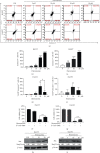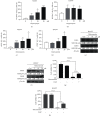A Marine Terpenoid, Heteronemin, Induces Both the Apoptosis and Ferroptosis of Hepatocellular Carcinoma Cells and Involves the ROS and MAPK Pathways
- PMID: 33488943
- PMCID: PMC7803406
- DOI: 10.1155/2021/7689045
A Marine Terpenoid, Heteronemin, Induces Both the Apoptosis and Ferroptosis of Hepatocellular Carcinoma Cells and Involves the ROS and MAPK Pathways
Abstract
Hepatocellular carcinoma (HCC) is a leading cause of death, resulting in over 700 thousand deaths annually worldwide. Chemotherapy is the primary therapeutic strategy for patients with late-stage HCC. Heteronemin is a marine natural product isolated from Hippospongia sp. that has been found to protect against carcinogenesis in cholangiocarcinoma, prostate cancer, and acute myeloid leukemia. In this study, heteronemin was found to inhibit the proliferation of the HCC cell lines HA22T and HA59T and induce apoptosis via the caspase pathway. Heteronemin treatment also induced the formation of reactive oxygen species (ROS), which are associated with heteronemin-induced cell death, and to trigger ROS removal by mitochondrial SOD2 rather than cytosolic SOD1. The mitogen-activated protein kinase (MAPK) signaling pathway was associated with ROS-induced cell death, and heteronemin downregulated the expression of ERK, a MAPK that is associated with cell proliferation. Inhibitors of JNK and p38, which are MAPKs associated with apoptosis, restored heteronemin-induced cell death. In addition, heteronemin treatment reduced the expression of GPX4, a protein that inhibits ferroptosis, which is a novel form of nonapoptotic programmed cell death. Ferroptosis inhibitor treatment also restored heteronemin-induced cell death. Thus, with appropriate structural modification, heteronemin can act as a potent therapeutic against HCC.
Copyright © 2021 Wen-Tsan Chang et al.
Conflict of interest statement
The authors have no conflicts of interest to declare.
Figures






Similar articles
-
Koumine Promotes ROS Production to Suppress Hepatocellular Carcinoma Cell Proliferation Via NF-κB and ERK/p38 MAPK Signaling.Biomolecules. 2019 Oct 2;9(10):559. doi: 10.3390/biom9100559. Biomolecules. 2019. PMID: 31581704 Free PMC article.
-
Benja-ummarit induces ferroptosis with cell ballooning feature through ROS and iron-dependent pathway in hepatocellular carcinoma.J Ethnopharmacol. 2024 Dec 5;335:118672. doi: 10.1016/j.jep.2024.118672. Epub 2024 Aug 8. J Ethnopharmacol. 2024. PMID: 39127118
-
Columbamine suppresses hepatocellular carcinoma cells through down-regulation of PI3K/AKT, p38 and ERK1/2 MAPK signaling pathways.Life Sci. 2019 Feb 1;218:197-204. doi: 10.1016/j.lfs.2018.12.038. Epub 2018 Dec 21. Life Sci. 2019. PMID: 30582951
-
Ferroptosis in hepatocellular carcinoma: Mechanisms and therapeutic implications.Biomed Pharmacother. 2025 Jan;182:117769. doi: 10.1016/j.biopha.2024.117769. Epub 2024 Dec 16. Biomed Pharmacother. 2025. PMID: 39689515 Review.
-
The involvement of ROS-regulated programmed cell death in hepatocellular carcinoma.Crit Rev Oncol Hematol. 2024 May;197:104361. doi: 10.1016/j.critrevonc.2024.104361. Epub 2024 Apr 16. Crit Rev Oncol Hematol. 2024. PMID: 38626849 Review.
Cited by
-
Fascaplysin Induces Apoptosis and Ferroptosis, and Enhances Anti-PD-1 Immunotherapy in Non-Small Cell Lung Cancer (NSCLC) by Promoting PD-L1 Expression.Int J Mol Sci. 2022 Nov 9;23(22):13774. doi: 10.3390/ijms232213774. Int J Mol Sci. 2022. PMID: 36430250 Free PMC article.
-
LHPP promotes the intracellular reactive oxygen species accumulation and sensitivity of gastric cancer to cisplatin via JNK and p38 MAPK pathways.Histol Histopathol. 2023 Sep;38(9):1055-1068. doi: 10.14670/HH-18-570. Epub 2022 Dec 7. Histol Histopathol. 2023. PMID: 36546683
-
The Regulatory Roles of Polysaccharides and Ferroptosis-Related Phytochemicals in Liver Diseases.Nutrients. 2022 May 30;14(11):2303. doi: 10.3390/nu14112303. Nutrients. 2022. PMID: 35684103 Free PMC article. Review.
-
The power of heteronemin in cancers.J Biomed Sci. 2022 Jun 15;29(1):41. doi: 10.1186/s12929-022-00816-z. J Biomed Sci. 2022. PMID: 35705962 Free PMC article. Review.
-
Role of ferroptosis and its non-coding RNA regulation in hepatocellular carcinoma.Front Pharmacol. 2023 Apr 13;14:1177405. doi: 10.3389/fphar.2023.1177405. eCollection 2023. Front Pharmacol. 2023. PMID: 37124203 Free PMC article. Review.
References
-
- Miyamoto M., Takano M., Kuwahara M., et al. Efficacy of combination chemotherapy using irinotecan and nedaplatin for patients with recurrent and refractory endometrial carcinomas: preliminary analysis and literature review. Cancer Chemotherapy and Pharmacology. 2018;81(1):111–117. doi: 10.1007/s00280-017-3454-y. - DOI - PubMed
-
- Demetri G. D., von Mehren M., Jones R. L., et al. Efficacy and safety of trabectedin or dacarbazine for metastatic liposarcoma or leiomyosarcoma after failure of conventional chemotherapy: results of a phase III randomized multicenter clinical trial. Journal of Clinical Oncology. 2016;34(8):786–793. doi: 10.1200/JCO.2015.62.4734. - DOI - PMC - PubMed
MeSH terms
Substances
LinkOut - more resources
Full Text Sources
Other Literature Sources
Research Materials
Miscellaneous

